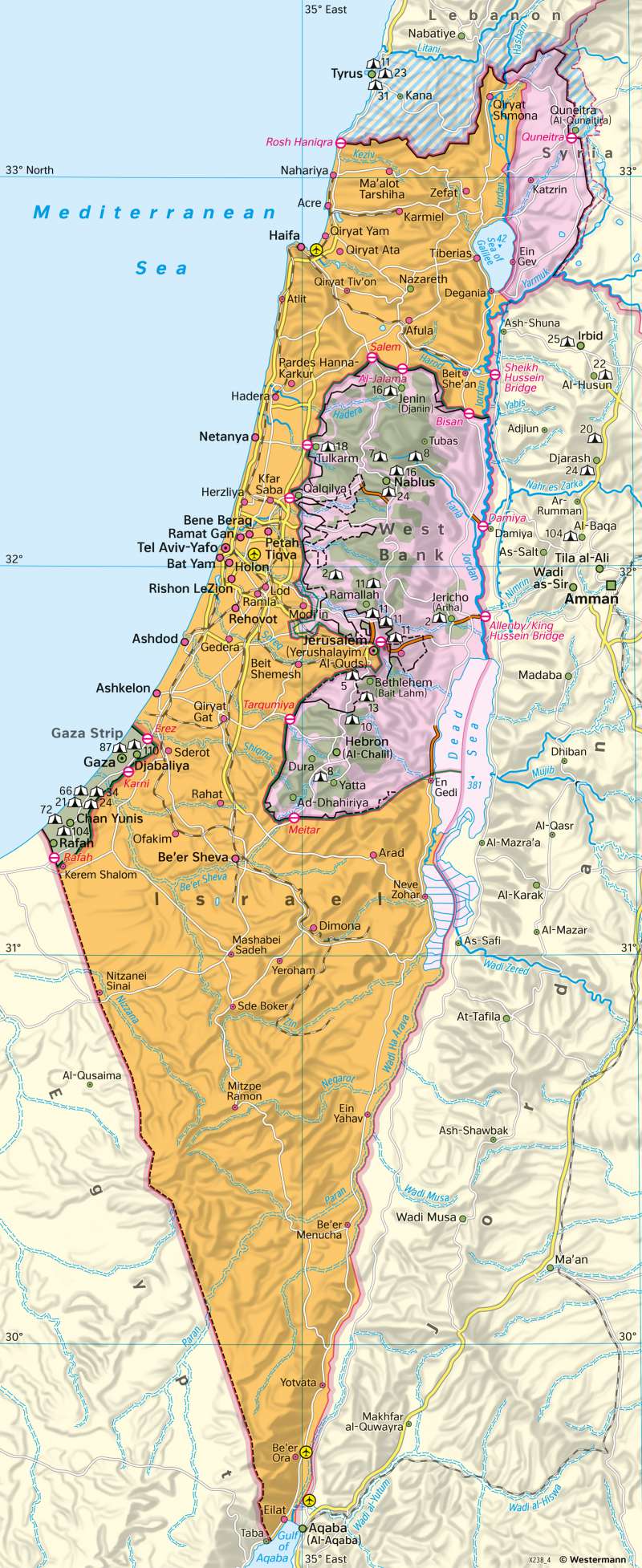Israel/Palestine - Territories and settlement
Physical map and the formation of Israel
978-3-14-100890-6 | Page 139 | Ill. 3

Overview
The first Middle East war of 1948 ended with the 1949 armistice line, which formed the border of the State of Israel for almost 20 years and divided the city of Jerusalem. A wall denied Israelis access to their holy sites in East Jerusalem, especially the "Wailing Wall".
Victory in the 1967 Six-Day War gave Israel control over the West Bank, the Syrian Golan Heights, the Gaza Strip, and the Sinai Peninsula. Israel later withdrew from the latter, but not from the other occupied territories. The conquest of East Jerusalem "reunified" the divided city from Israel's point of view.
From 1967 onwards, settlement policy was increasingly aimed at securing conquered territories by establishing Jewish settlements, especially in the greater Jerusalem area. Palestinian land was expropriated on about a third of the area of East Jerusalem in order to build ten settlements on it, followed by many more. Although the expansion of settlements was sharply criticised internationally because it violated international law, the national conservative Likud bloc deliberately pushed it forward after coming to power in 1977, among other things by offering financial incentives to settlers. In 1980, the eastern part of Jerusalem was formally annexed by the "Jerusalem Law", which declared the city the eternal and indivisible capital of Israel.
Israeli–Palestinian conflict nowadays
Subsequent governments of Israel also promoted settlement construction in the West Bank. For the Palestinians, the settlement policy has led to a severe fragmentation of their territory, which continues to hamper its urban and infrastructural development to this day. Palestinian agriculture suffers from both land loss and the cutting off of water sources.
The 1994 Gaza-Jericho Agreement between Israel's Prime Minister Yitzchak Rabin and Yasser Arafat of the PLO created the Palestinian Territories, consisting of the Gaza Strip and large parts of the West Bank. However, the assassination of Rabin (1995) and numerous terrorist attacks hardened the fronts again shortly afterwards. When Prime Minister Ehud Barak withdrew Israeli troops from southern Lebanon in 1999, the rapprochement process began to move again, but the negotiations begun under US mediation at Camp David failed. Barak's successor Ariel Sharon provoked the Second Intifada with his visit to Jerusalem's Temple Mount (2000). Israel responded to the wave of suicide attacks on Israeli civilians with military strikes, temporary border closures and the construction of fortified border fortifications, some of which run directly through Palestinian residential areas. About two-thirds of the originally planned barriers have already been built. It is still uncertain whether the others will be built, because the number of attacks has fallen sharply, the expansion would be associated with high costs and, moreover, meets with international rejection.
A sign of a de-escalation of the permanent conflict was the withdrawal of about 7000 settlers from the Gaza Strip and four settlements in the West Bank in summer 2005. Nevertheless, there have been repeated violent incidents, some of them deliberately provoked by the Palestinians, such as the launching of short-range rockets from the Gaza Strip and suicide bombings. In the last serious clash between Palestinian groups and the Israeli army in the summer of 2014, around 18,000 housing units and large parts of the infrastructure in the Gaza Strip were destroyed in such a way that it will take years to rebuild.
On 10 May 2021, a renewed conflict with strong confrontations began between Israel and Palestine, which ended with a ceasefire on 21 May 2021. At least 248 Palestinians and 12 Israelis have been killed, several thousand people injured and several tens of thousands of Palestinians forced to flee.




